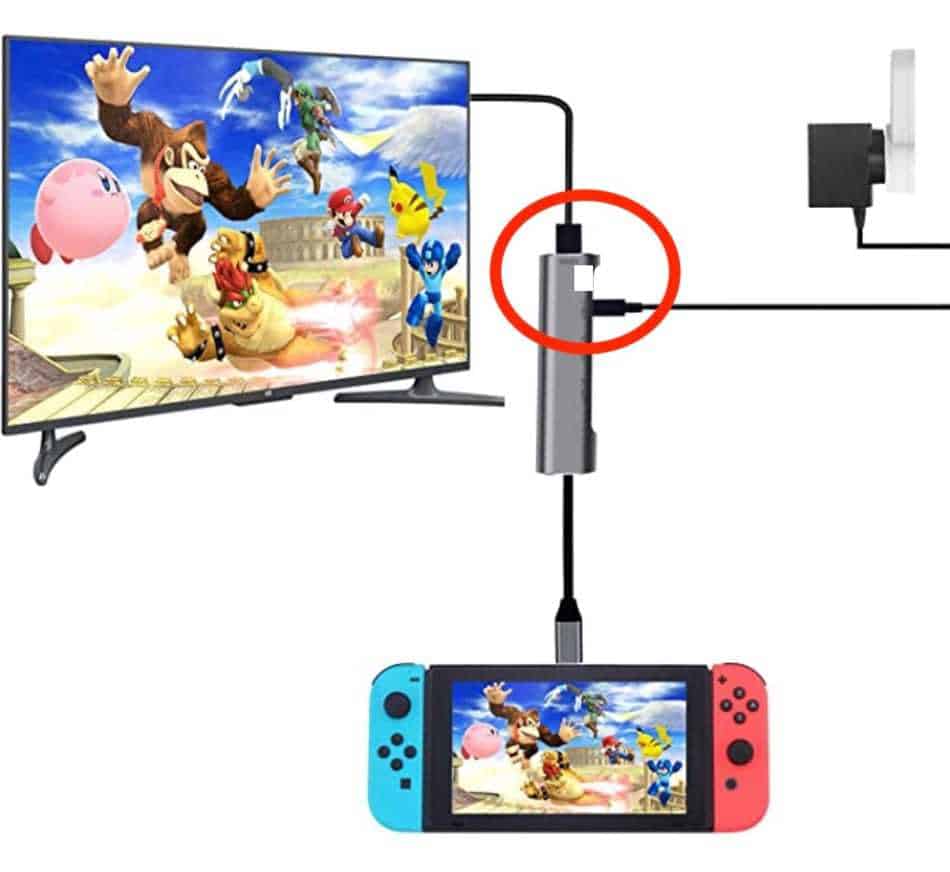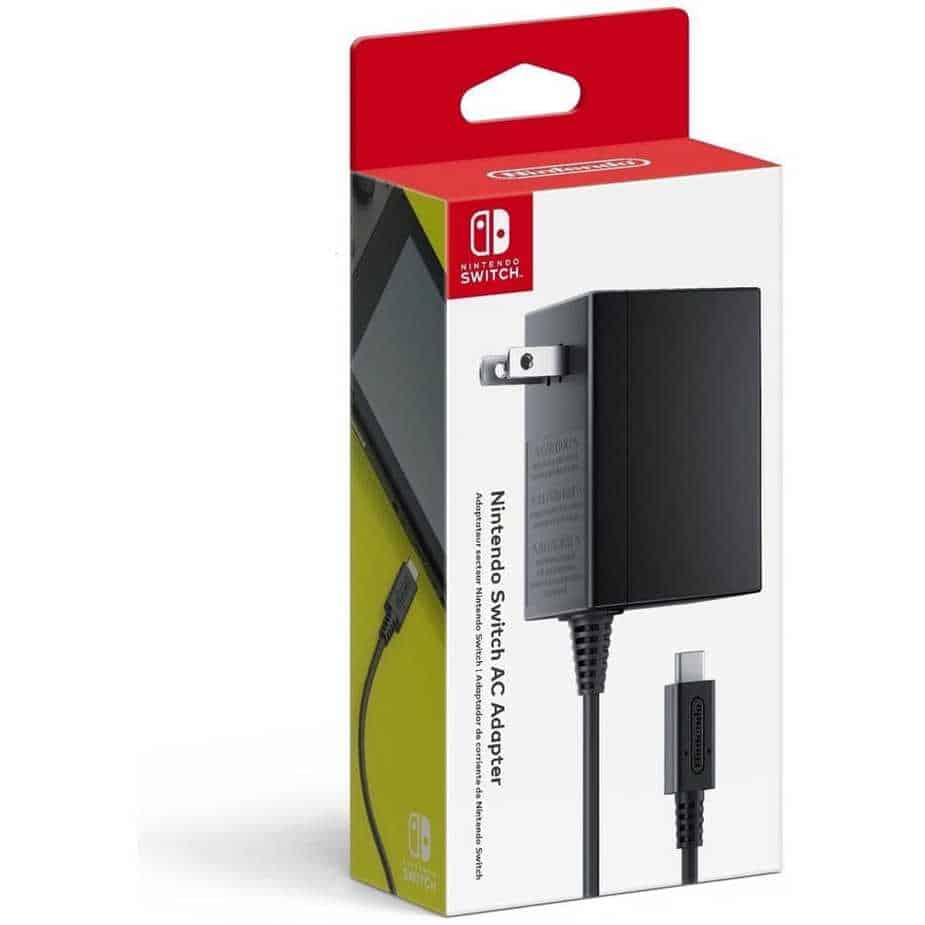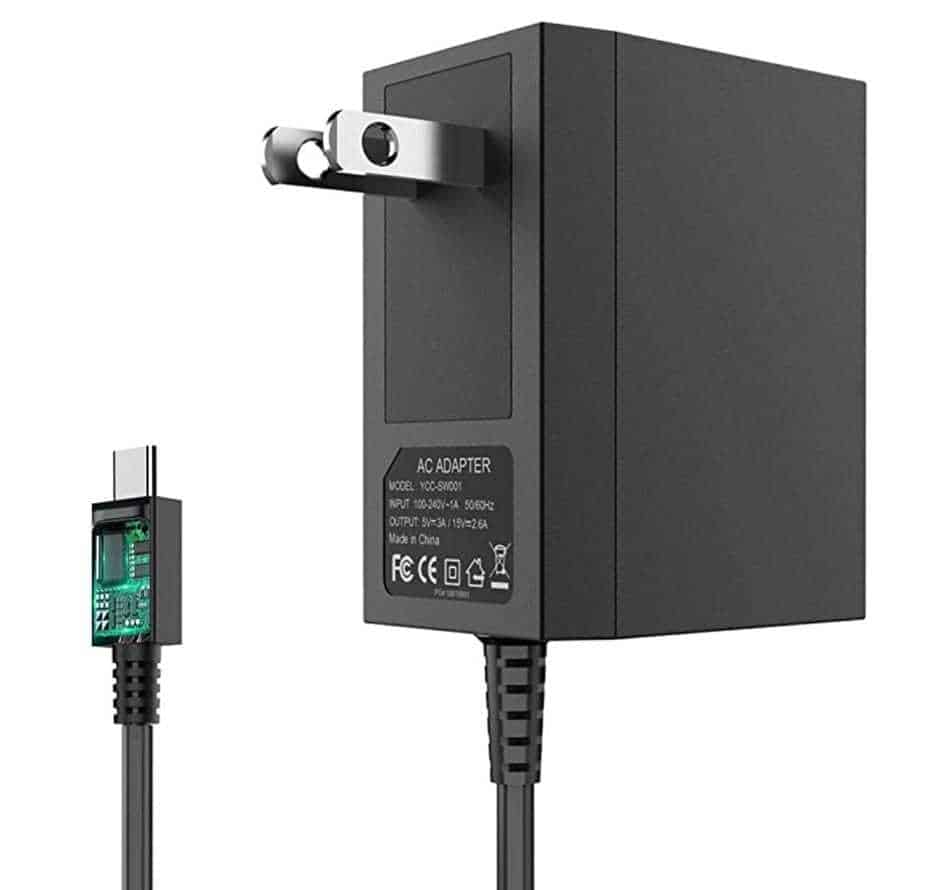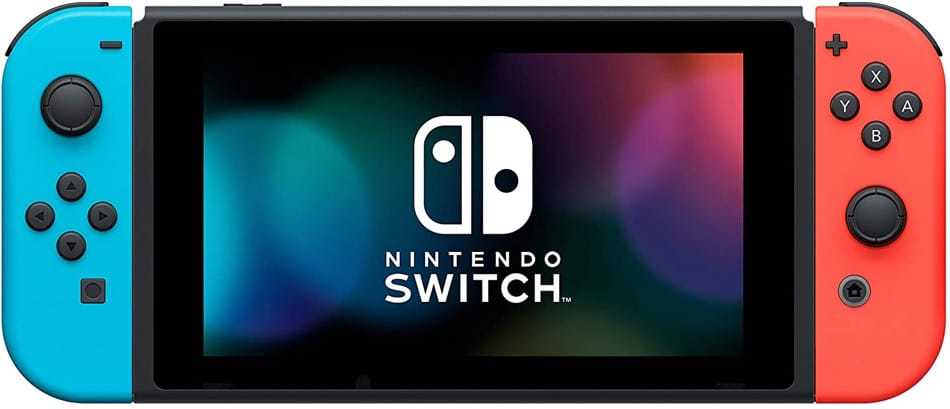Ever had that sick feeling in your stomach when you power up your console and all that greets you is a blank screen.
No Nintendo Switch home screen. No Chim from the PS4. Just a black abyss.
I had this problem recently with my Nintendo Switch. No matter what cable I jiggled, I couldn’t get an image from my Switch to my TV using the official Nintendo Switch dock.
So I did what most people would do when their stuff has broken: I went shopping!
I surfed over to Amazon.com in search of a new dock and I eventually found one. But I was shocked, nearly to death I might add, when a monster price tag slapped me in the face. $70? For a chunk of bendy, squidgy and creaky plastic? No thanks!
Seeing this frankly ridiculous price motivated my problem-solving juices to flow:
How could I connect my Nintendo Switch to a TV without the dock? After meditating over this question for a while, I realized that I couldn’t be the only person suffering from this dock-induced debacle.
So, like the duty-bound content-creator that I am, I shook awake my iMac, and after it stirred to life, I started the hunt for an answer. This is what I found:
How do I connect the Nintendo Switch to a TV without the Dock? To connect your Nintendo Switch to a TV without a dock you will need a special adapter designed to mimic the Switch’s dock. You will need to use the Switch’s power adapter or an equivalent adapter to get a picture from your Switch to your TV. A typical USB-C to HDMI cable will not work with your Nintendo Switch.
Now you know it is possible to connect your Nintendo Switch to your TV without a dock. In the following sections, I’ll explain how to actually do the connection process, and then I’ll answer a couple of other questions about other methods of connecting your Switch to your TV.
Why Connecting The Nintendo Switch to a TV Without a Dock Isn’t Straightforward
Sadly connecting your Switch to your TV is not as simple as just plugging a USB-C to HDMI cable into your Switch and TV.
Unfortunately, Nintendo dipped into their vast resources of wisdom and pulled out a fine idea: “Why don’t we make connecting the Switch to TVs without a dock as complicated as possible because, well, why not!”
And that’s exactly what they did.
The data sent from the Switch to your TV is not only encoded, but it will only send if the Switch is in a very specific state before the data is sent. The Switch needs to have the perfect combination of power delivered to it by the power adapter and a signal from a TV before it will send an image to a TV.
For example, the official Nintendo power adapter is rated as 15V and 2.6 amps which provides a total power of 39 Watts.
If the Switch doesn’t detect this exact power input as soon as you connect it to the TV with a dock or adapter, the Switch won’t send an image.
However, Nintendo’s reasoning for this is simple and, though I despise myself for admitting this, it kind of makes sense: the Switch needs the power adapter with that exact spec before sending a picture to a TV because, when in docked mode, the Switch’s hardware needs the extra power to generate higher resolutions and frame rates. The signal from the power adapter whispers to the Switch. “Just to remind you, you’ve got enough juice now to rev-up that awesome combo of a GPU and CPU. It’s cool to send a picture to the TV now” And so the Switch transforms into a 1080p@60 fps Breath of the Wild playing beauty.
The switch will only send an image to your TV when it’s absolutely sure it’s getting the extra power it needs to do so.
Without the extra power, the Switch stays in handheld mode, and won’t output an image to the TV.
So, how exactly do you get an image from your Switch to your TV without the dock?
In steps Captain Special Adapter!! (Sorry, I’ve been reading marvel comics!)
How to connect your Nintendo Switch to your TV without a Dock

To get an image from your Switch to your TV you’ll need a special HDMI/USB-C adapter that mimics the Switch’s dock.
However, just as in docked mode, you’ll still need a power adapter that is specifically designed for the Switch.
Let’s take a look at the method.
What you’ll need before you start:
- RREAKA USB Type C to HDMI Digital AV Multiport Hub, USB-C (USB3.1) Adapter PD Charger for Nintendo Switch
- This has thousands of 5-star reviews on Amazon and is my Adapter of choice
- Nintendo Switch official Power adapter or 3rd party power adapter made for Nintendo Switch. Don’t try and use a different adapter, it won’t work.
- Your Nintendo Switch
- A braided HDMI Cable. Braided cables are better for transporting
- The desired TV/Monitor you wish to connect to.
The Method.
1: Ensure that you have the All the components ready above.
2: Plug your Nintendo Switch Power adapter into the wall socket and power it on. Lead the USB-C end of the power lead around to the front of the TV
3: Plug the HDMI into the back of the TV and lead the other end around to the front of the TV.
4: Take the RREAKA Nintendo Switch adapter in hand. Plug the USB-C power adapter into the USB-C socket.
5: Next, plug the HDMI cable that’s running from the back of the TV into the HDMI slot on the RREAKA.

!! IMPORTANT !!
For the adapter to work correctly it is vital that the Power and HDMI leads are plugged into the RREAKA adapter first and powered on before inserting the RREAKA into the Switch. If you don’t assemble the adapter in this specific order, the Switch will think it’s still in handheld mode.
6: Turn on your Switch’s screen while in handheld mode and navigate to the home screen. This will make it easier for you to know if the process has worked
7: Ensure the TV is on and tuned to the correct HDMI source, for example, HDMI 1.
8: Now, with both the HDMI cable and power adapter plugged into the RREAKA adapter, plug the adapter into the Switch.

9: The Switch’s screen should power off and the home screen should appear on your TV.
10: Put the Switch on its front, screen down, on a soft cloth. Doing this will the cooling vents on the back of the Switch have access to fresh cool air. If the Switch is placed on its back it will eventually overheat.
11: You can now use your Nintendo Switch with your TV as if it were using the official Nintendo Switch Dock.
Troubleshooting
I’ve got no picture.
Make sure that you plugged in the power adapter and the HDMI into the RREAKA Nintendo Switch adapter and powered them on before you plug the RREAKA into the Switch.
Can I use Nintendo Switch Pro Controllers with the RREAKA adapter?
Yes, you can.
Can you connect the Nintendo Switch to your TV wirelessly?
Unfortunately, the Nintendo Switch doesn’t have the ability to output an image wirelessly.
The only way you can extract an image from a Nintendo Switch to a different display is by using the official dock or an adapter like the RREAKA for Nintendo Switch.
You can buy wireless HDMI receivers. But you don’t want to use these, Seriously. They are bulky antenna stalked things and they are not the best choice for the Switch for so many reasons. The best (or is that worst?) reason is that, because of the loss of data during wireless transmission, there is a massive 0.3-second delay between controller input and action on the screen.
To put that into perspective, on 60fps shooter such as Call of Duty typically has a controller to screen delay of about 0.016 seconds. That makes the input lag from wireless HDMIs 19 times worse than with a typical 60fps game.
Is it possible to charge the Nintendo Switch without a dock?

Yes, you can charge the Switch without the dock.
The best way to charge the Switch is by using the official or 3rd party Nintendo Switch power adapter as this provides enough power to not only play the Switch but to charge it at the same time.
The official adapter operates at 15V and 2.6 amps. This provides 39 Watts of power which is well above most fast charging mobile phone adapters.
Alternatively, any USB C cable plugged into a USB power plug will charge the Switch.
However, it worth keeping in mind that different power plugs will charge the Switch at different rates. Most Mobile phone power adapters offer much less power than the official Nintendo Switch adapter. So the Switch will charge slower.
For example, this 18W charger will charge the switch slower than the official charger. But it’s still more than enough power to charge the switch in a few hours.
It’s also worth keeping in mind that the Switch will not charge faster if you use a power adapter that outputs more than 39 watts of power.
Why is my Switch Dock not working

I originally bought my Switch when they were first released way back in 2017. In that time, I’ve used the Switch nearly exclusively in docked mode.
The problem is, I’ve moved the Switch around in my dock probably more times than I should have. This jiggling and wiggling of dock and Switch eventually made the dock die.
So I know what it’s like to have a Switch dock fall into an early grave. So here’s a list of the main things to check before declaring your Dock dead-on-arrival.
1: Is the power adapter plugged into the wall socket?
Check that the power adapter is plugged correctly into a wall socket. Sometimes they can work their way free without you realizing or a pet/child could have snagged it.
2: Is the USB-C end of the power adapter plugged in?
Sometimes the USB-C inside the Switch dock can be a little loose. This leads to the USB-C cable easily falling out of the socket at the lightest touch of the dock. Check that it’s still plugged in. This is what happened with my Switch dock. The USB-C socket became so loose that I had to duct tape the darn thing in place!
3: Is the USB-C socket the Switch slides onto in the dock ok?
Check that the socket is ok. Does it look deformed? Is it misaligned? If so, it may need a fix or a replacement dock/adapter.
4: Is the Switch’s charging socket OK?
Check that there’s nothing inside the Switch’s USB charging socket. Give it a clean if necessary. Take a look at my article here to learn how to clean the Switch’s charging socket.
4: Is the HDMI lead plugged in correctly?
Check both ends of the HDMI lead. It can work its way loose.
5: Is your TV’s HDMI socket ok?
TV HDMI sockets do stop working. Try a different socket before declaring your dock dead.
6: Is your TV switched over to the correct HDMI channel?
This is a mistake I’ve made hundreds of times over the years. Make sure your TV is tuned into the correct HDMI channel.
7: Is everything powered on?
Check that your TV/Switch is powered on.
Conclusion
It wouldn’t be one of my articles if I didn’t end with a nice and concise bulleted summary of the entire article. Let’s take a look at the main points covered:
- You can connect the Switch to your TV without the Nintendo Switch Dock
- You’ll need an adapter that is designed to mimic the Switch dock’s functionality
- One such adapter is the RREAKA for Nintendo Switch
- For it to work correctly you must plug the HDMI and Power adapter into the RREAKA before you plug the RREAKA into the Switch. Otherwise, the Switch will stay in handheld mode
- USe either the Nintendo Switch official Power adapter or 3rd party power adapter
- You can’t connect the Switch to a display wirelessly
- It is possible to charge the Switch without the dock
- You can use the official Switch power adapter or Switch 3rd part adapter
- You can also use a USB-C cable plugged into a USB charging plug
- 3rd party USB charging plugs will charge the Switch slower
- There are many reasons why the Switch dock may not work
- Read through the above section again and double-check all the docks connections and cables
- Ensure the TV/Switch is switched on and tuned to the correct HDMI channel
What Next?
How do you clean the Nintendo Switch charging port? Cleaning the Nintendo Switch charging port can be done with a few simple tools. Check out my article here to see how it’s done.
How do I clean the Nintendo Switch’s vents? The vents can be cleaned easily with compressed air, a vacuum cleaner, and some antistatic brushes. However, it is possible to damage the Switch if you are not careful. Check out my article here to see how to clean your Switch’s vents.
What was that adapter you mentioned? The adapter I used for my own Nintendo Switch and for the method in this article is the RREAKA USB-C adapter for Nintendo Switch

